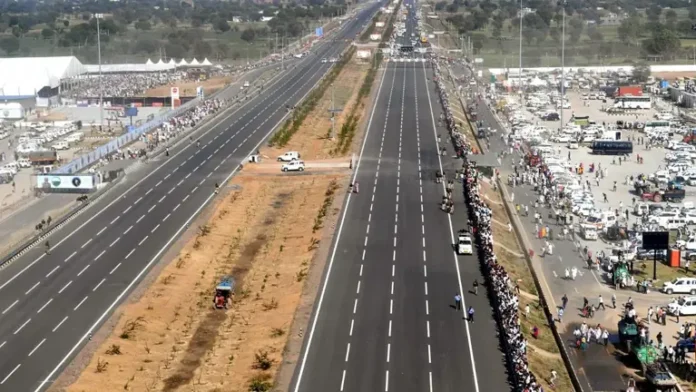The Delhi-Dehradun Expressway is set to revolutionize travel between the national capital and Dehradun, offering a more convenient and faster route for commuters. One of the most exciting features of this ambitious infrastructure project is the 32-kilometer stretch from Akshardham to Baghpat, which will significantly reduce travel time. Once completed, this section will allow vehicles to cover the distance in just 25 minutes, a drastic reduction from the current time it takes to traverse the route.
This significant development is part of the ongoing efforts to modernize India’s road infrastructure and enhance connectivity between key cities. The expressway promises to reduce travel time, ease traffic congestion, and provide a smoother and safer driving experience, benefiting both locals and travelers alike.
Faster Travel with Improved Connectivity
The Delhi-Dehradun Expressway, when fully operational, is expected to cover a distance of approximately 210 kilometers, connecting Delhi to Dehradun. This vital road infrastructure is expected to be a game-changer in terms of speed and connectivity, with commuters traveling from Delhi to Dehradun much faster than before. The project, being implemented in phases, is already seeing rapid progress.
The stretch from Akshardham to Baghpat is one of the first sections to be completed, marking a significant milestone for the expressway project. The 32-km distance, which usually takes more than an hour to cover due to traffic congestion and inefficient roadways, will now take just 25 minutes. This time-saving improvement is set to make a tremendous difference for travelers, especially those who frequently commute between the two cities for work or leisure.
Key Features of the Delhi-Dehradun Expressway
The Delhi-Dehradun Expressway will feature several state-of-the-art features aimed at improving the overall driving experience. These include:
- High-Speed Lanes: The expressway is designed to facilitate smooth, high-speed travel, with multiple lanes to accommodate heavy traffic during peak hours. The lanes will be wider and more efficient, enabling vehicles to maintain faster speeds while ensuring safety.
- Dedicated Service Roads: To ease congestion, the expressway will also have dedicated service roads for local traffic, which will help keep the main lanes clear for long-distance commuters. This will be especially beneficial for those traveling from nearby areas and will reduce bottlenecks.
- Dedicated U-Turns and Flyovers: The design incorporates well-planned flyovers and u-turns at key intersections, ensuring seamless connectivity while avoiding delays and interruptions in traffic flow.
- Smart Features and Surveillance: The expressway will be equipped with smart features, including CCTV surveillance, vehicle tracking, and emergency service points. These technological improvements will enhance safety, reduce accidents, and ensure quick assistance in case of emergencies.
- Eco-Friendly Measures: The construction of the expressway is being carried out with an emphasis on sustainability. Efforts are being made to reduce the environmental impact of the project, including the planting of trees along the route and the use of eco-friendly materials.
Reduced Traffic Congestion
One of the major concerns on the current route between Delhi and Dehradun is the heavy traffic congestion, particularly around the Baghpat area. This congestion results in delays and longer travel times, causing frustration for commuters. The completion of the Akshardham-Baghpat stretch will help alleviate this issue, as the expressway will bypass local traffic and reduce pressure on older, narrower roads.
The reduction in travel time is expected to benefit not only daily commuters but also tourists and businesses that rely on quick transportation between Delhi and Dehradun. With the expressway in place, people traveling for business meetings, leisure, or educational purposes will be able to reach their destination more efficiently.
Economic Impact
The Delhi-Dehradun Expressway will have significant economic implications. By improving connectivity between Delhi and Dehradun, it is expected to boost tourism in the region, providing easier access to popular destinations such as Mussoorie, Haridwar, and Rishikesh. The expressway is also likely to promote economic growth in the surrounding areas by facilitating the movement of goods and services, thus improving trade and commerce.
The reduction in travel time will also have a positive impact on the environment. By reducing congestion and traffic, the expressway will help minimize carbon emissions, contributing to a cleaner and more sustainable future.
Enhancing the Commute Experience
The enhanced commute experience provided by the expressway is not only about reducing travel time. With smoother roads, fewer traffic jams, and better safety features, the Delhi-Dehradun Expressway will make traveling far more comfortable for drivers and passengers alike. Additionally, the inclusion of rest areas, fuel stations, and food courts will make long journeys more convenient, offering travelers the chance to take breaks and refresh during their trip.
Future Prospects
While the Akshardham-Baghpat stretch is already functional, other sections of the Delhi-Dehradun Expressway are also under construction. The full project, once completed, will further enhance the travel experience, cutting down travel times between Delhi and Dehradun to just 2.5 hours. This will make the entire stretch of road from Delhi to Dehradun a modern, fast, and reliable route for commuters, tourists, and businesses.
The 32-kilometer stretch of the Delhi-Dehradun Expressway from Akshardham to Baghpat is a significant achievement in India’s road infrastructure development. By reducing travel time to just 25 minutes, it has the potential to drastically improve the daily commute and bring substantial benefits to residents and travelers. With its state-of-the-art features, better traffic management, and improved safety measures, this section of the expressway sets the stage for a more efficient and enjoyable journey to Dehradun. As the rest of the expressway is completed, this project will likely become a model for future infrastructure developments in the country, enhancing connectivity and contributing to economic growth.

